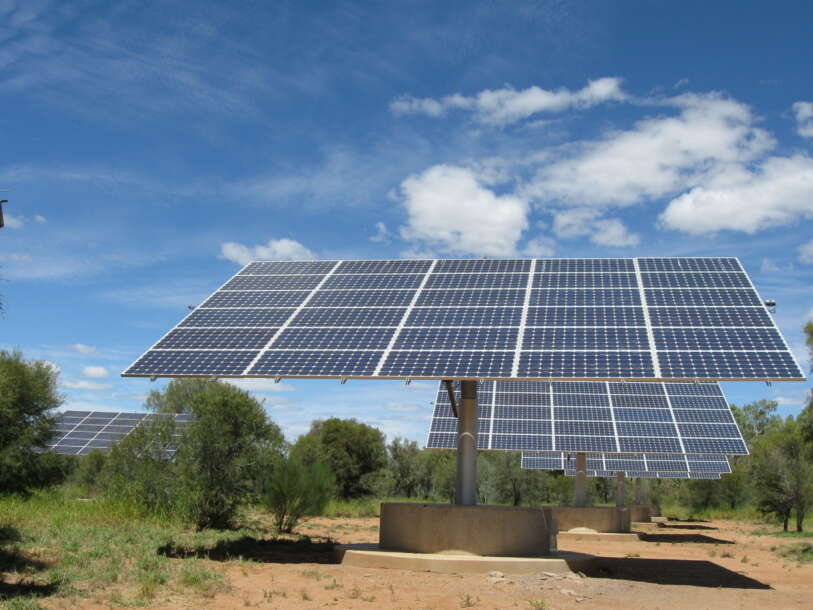| Manufacturer | Trina |
|---|---|
| Array Rating | 10.5kW |
| PV Technology | mono-Si |
| Array Structure | Tracker: Dual Axis |
| Installed | 2009 |
View on Map Graphs Download Data
Current Output

Trina monocrystalline silicon array, large-scale dual axis trackers.
These dual-axis tracking arrays adjust the orientation of the panels through the day to maximise their exposure to the sun.
To take advantage of the available area on the tracking array, efficient monocrystalline panels have been used.
The trackers operate by continually monitoring light intensity, and processing this information to drive the arrays’ motorised supports. At sunrise, light hitting the sensor at the rear of the control units will trigger movement back towards the east. On a completely overcast day, the panel surface adjusts to horizontal.
The control and drive systems use less than one watt of DC power from the array's output. Tracking is expected to increase this array's output by 35%.
The long term performance of these tracking arrays can be compared to that of the fixed Trina monocrystalline array to see the gain contributed by the trackers at different times of the year.
Solar Inception delivers complete photovoltaic power plants. They are distributors for Trina Solar, a photovoltaic manufacturing company based in China.
*This system was originally 6 trackers of TRINA 175W PV modules. On 14th August 2013, 4 of the trackers had their TRINA 175W PV modules changed out with TRINA 195W PV modules and this system (SITE 1A) has been reduced to 2 trackers. A new system with the new 195W modules on the other four trackers has been created (site 1B). This change was at the request of TRINA who had identified a discolouration issue with some of the 175W PV modules. This discolouration was not affecting performance at this stage and was deemed to be caused by a faulty batch of back sheeting. Two of the six trackers have retained the original PV modules to allow assessment of their long term performance.
| Array Rating | 10.5kW |
|---|---|
| Panel Rating | 175W |
| Number Of Panels | 2 x 30 |
| Panel Type | Trina TSM-175DC01 |
| Array Area | 2 x 38.37 m² |
| Type Of Tracker | DEGERenergie 5000NT, dual axis |
| Inverter Size / Type | 2 x 6 kW, SMA SMC 6000A |
| Installation Completed | Thu, 8 Jan 2009 |
| Array Tilt/Azimuth | Variable. Dual axis tracking. |

Notes on the Data
-
Site 1 tracker alignment
Over the past few years, all but one of the Degerengie trackers at site 1A and 1B have been progressively failed. Mostly due to sensor and control board issues, though motor failures are also a factor on some trackers.
As trackers had failed pointing in different directions, all the dysfunctional trackers have now been aligned to face north with a 10 degree tilt. This orientation is was chosen to allow self cleaning but minimize windage.
The one functional tracker is located on site 1, and will be allowed to continue to track.
-
Some system issues.
The following sites have on going power issues due to a range of factors:
- Site 1A dysfunctional tracker
- Site 1B 2 x Failed PV inverters and dysfunctional trackers
- Site 2 2 x Failed PV inverters and dysfunctional tracker
- Site 5 AC cable fault
- Site 22 1 x failed tracker
- Site 33 1 x Failed PV inverter
Remediation work is underway and each array will be returned to full operation as soon as possible.
-
Sites 1A, 1B & 22 (trackers): Cabling and Maintenance at Height
Cable tidying and other maintenance work at height were conducted for these tracking arrays, which were powered off at respective times: site 1A & 1B (8.30am-2.00pm) and site 22 (2.00-4.30pm). All connections have been restored.
-
System Disconnection for Cabling Works
All arrays at the Solar Centre were disconnected from approximately 2.00pm to 3.00pm on Monday, 9 July 2018 in preparation for the cable between the main switchboard and distribution board being upgraded. Array sites #23-38 remained disconnected while the main feeder cable to these sites was replaced in subsequent days, but all systems were re-connected by early afternoon on Thursday, 12 July 2018.
-
Monitoring Interruption for UPS Battery Replacement
The disconnection and re-connection of the solar arrays and weather station equipment while a new site connection was being established prompted the already flattening UPS batteries which power the site’s energy meters to fail and require immediate replacement. Data recording was affected from approximately 2.30pm ACST, Monday 10 July to 4.00pm, Wednesday 12 July.
Affects weather data for DKASC, Alice Springs
-
Site 1A: Hot Spots
A recent annual maintenance inspection observed hot spots on two solar modules: the third module from the top, east end on Tracker #3, and the second module from the bottom, east end on Tracker #4.
-
Site 1A and 1B: Configuration Changes
SITE 1: Large Scale Tracke: Degerenergie has been modifed. Originally 6 trackesr each with 30 x 175W Trina PV modules, this has now been split into two systems - SITE 1A. Two Degerenergie trackers each with 30 x 175 W Trina Modules - SITE 1B. Four Degerenergie trackers each with 30 x 195 W Trina Modules. These are new PV modules This change was at the request of TRINA who had identified a discolouration issue with some of the 175W PV modules. This discolouration was not affecting performance at this stage and was deemed to be caused by a faulty batch of back sheeting. Two of the six trackers have retained the original PV modules to allow assessment of their long term performance.. The two new sites will be fully integrated into the website, whilst the original data stream is still available for download but will no longer be available on the automated graphing. The following list provides a summary - Original SITE1 : Large Scale Trackers, DEGERenergie - New SITE 1A : DEGERenergie Trackers & TRINA 175W - New SITE1B : DEGERenergie Trackers & TRINA 195W
-
Site 1A and 13: PV Module Discolouration
An orange discolouration of the majority of the PV modules on these arrays was noted in 2013. Investigation by the module manufacturer identified that the cause was the use of a particular back sheet material that on thermal and UV exposure has begun to breakdown and released the discolouring agent into the EVA. On these same arrays a several PV modules that utilized a different back sheet material have not been effected by this at all. Despite this discolouration no significant impact on the arrays performance has been noted to date. The module manufacturer did request to change out the effected PV modules, but for the benefit of the industry and to allow the progress of this issue to be observed over many years they kindly agreed to leave the majority of these PV Modules in place. The only PV modules that were changed out was the PV system now nominated as Site 1B, which was subsequently separated off as its own distinct array. Sites 1A and Site 13 retain the original PV modules.
-
Site 1A: DEGERenergie Tracker Issue
One of the two DEGERenergie trackers shifted into horizontal position and is no longer tracking on the tilt axis but only rotates on the azimuth axis. Despite the installation of a replacement tilt drive motor this issue has not been resolved. No local support has been available from tracker manufacturer and no further attempts will be made to resolve this issue.
> Answer to Spotlight Question
Onsite at the DKA Solar Centre in Alice Springs are a series of quiz-like Spotlight Questions at each array. Visit the centre and scan the QR code at each sign to test your knowledge – and check your answer here!
Q: What are some other tracking mechanisms used by other arrays in our Solar Centre?
A: Solar trackers may be single- or dual-axis types. Single-axis trackers follow the sun's path from east to west throughout a day, while dual-axis types additionally adjust their tilt angle depending on the sun's height in the sky at different times. Tracking paths may be based on pre-programmed timers, light sensors or heat sensors. While the mechanical movement is normally driven by a motor, passive systems have also been pursued, for example, using hydraulics which require no electrical input to operate but respond to ambient heat.




